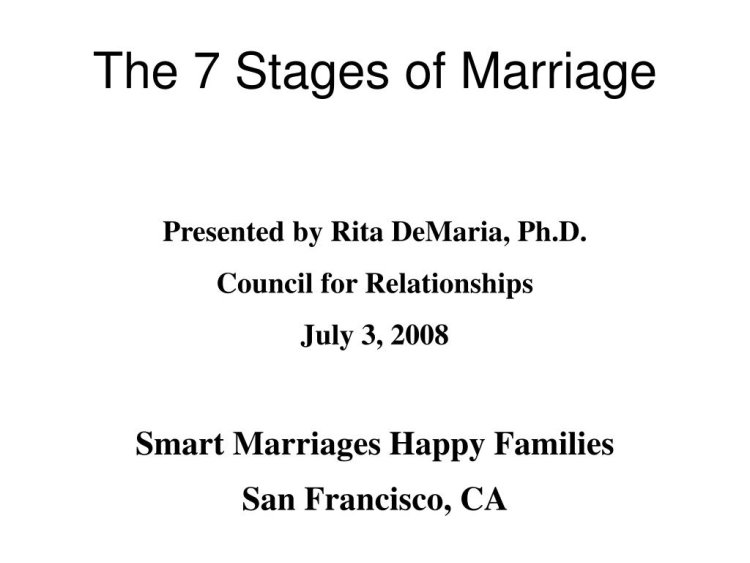The 7 Stages Of Marriage

Are you familiar with the various stages of marriage? When we are young, we think of life in two parts: before marriage and after marriage. But some people stay married for the majority of their lives, sometimes 80 years or longer.
Marriage can be best understood when viewed as a series of stages, or phases, that most couples work through while spending their lives together. These seven stages of marriage are interconnected, and yet each one is distinct and somewhat separate from the others. Knowing what to expect, and more importantly, how to plan, can help each couple weather the adjustments more readily. Below is a description of the stages of marriage that apply to many married couples today.
The Honeymoon Phase
Universally acknowledged as romantic, tender and idealistic, the “honeymoon” stage of marriage occurs immediately after the wedding through the next several months, possibly lasting as long as a year or two. In fact, in ancient Israel the army would not conscript men for the first year of their marriage to give them time to start building the relationship, a home and the couple’s family. Characterized by passion, sexual intimacy and infatuation, this stage can be extremely sensitive and volatile, and provides a nurturing environment for marital bonding.
The Adjustment Phase
They don’t say “the honeymoon’s over” for nothing! The second stage of marriage takes place as the first comes to an end—sometimes gradually, at other times suddenly, depending on the circumstances affecting bride, groom and their life together.
Essentially, the couple’s preoccupation with each other and their new, united relationship begins to wind down.
Pulled back into the “real world” by other responsibilities, including work, in-laws, homemaking, child-rearing, and their growing familiarity with one another, this stage is an epiphany, or awakening, to the “whole picture” of marriage. The awareness that you have married someone who is imperfect, and perhaps displays undesirable or even questionable qualities, can lead to some sobering reflections and “what-have-I-gotten-myself-into” moments.
The Great Escape Phase
After the first three years or so, power struggles may erupt as both spouses claim their turf and draw their lines of defense. In this stage of marriage, husbands and wives begin to realize they married someone with as many vices as virtues, and each one reverts to re-inventing themselves in new ways that may only partially include the spouse. Within this stage comes the “seven-year itch,” which many marriage counselors now suggest might arrive earlier for some couples, perhaps at three or five years. The danger of an affair becomes apparent as disillusionment, conflicts and frustration replace the earlier passion and adjustments.
The Reassessment Phase
Late in the first decade of marriage, and often into the second decade, couples become more accustomed to their situation and each other’s quirks. They begin to mature, especially if children are present or they have had good role models or mentors.
Recommitting themselves to the marriage rather than opting to bail out, they evaluate the strengths and weaknesses of their union and set to work on reestablishing themselves as a couple while enhancing family life.
The Growing Together Phase
Surviving boredom, conflict and temptation thus far, the couple may find peaceful time during their second or third decade together. Suddenly, there is a second opportunity to rediscover each other. As children grow up and go off to college, and one or both spouses settle into satisfying careers, this is an excellent opportunity for them to focus on each other again, rather than juggling kids, jobs and tensions that come with the territory of marriage. Renewal ceremonies and second honeymoons are becoming more commonplace as couples pledge themselves all over again to one another. Remember the pledged words: Until death do us part.
The Midlife Strife Phase
While midlife changes are manifested in women during their 40s and 50s (and sometimes in their 30s) through biological and emotional adjustments, both sexes may experience a psychological midlife “crisis” experience where they reach the pinnacle of married life or career. They suddenly see the downhill slide of the other half of their lives. The thought of approaching retirement and aging can be so unnerving to some folks that they overreact in an obsessive quest for youth to hold on to their “best years,” sometimes by abandoning their spouses in a quest for a younger “model.”
Empty-nest syndrome can wreak havoc as well, with the couple focusing on each other instead of the kids, which comes with its own type of reawakening phase—both good and bad. Compounding these issues are others associated with middle age, such as losing parents, declining health and the loss of a job.
All of these things can bring out the worst in us, leading to finger-pointing, regrets, accusations and confrontations. Strong, committed couples will find a way to weather the storm. Others, sadly, may fall by the wayside as their marriages disintegrate.
The Fulfillment Phase
After a few decades, the husband and wife realize in this stage of marriage that they have somehow managed to stay together, and they are contented to do so for the rest of their lives. For some couples, this may entail simply looking back on their earlier years together and being thankful they had each other through good times and bad. For others, the fulfillment phase is “falling in love all over again,” realizing that they have chosen the best possible life partner, and being grateful to have that person in their life as they grow old together. Through thick and thin, they have stood by each other and survived many losses as well as celebrated life’s joys. At this point they have no thought for anyone else, just the satisfaction of being with the person they truly love above all else.
Your different stages of marriage may not follow this particular order. Or you might even experience things that are not included in this list. The main point is that few marriages operate in one level consistently throughout the life-long course of two people who have chosen to get married. Things change. Life happens. People go through a series of experiences that can impact the way they feel about a spouse.
Today’s divorce rate hovers just below the 50 percent mark, which is better than it was a few years ago, but it is still too high. With better understanding of what to expect and how to respond in a marriage that spans several decades, couples have a better chance of sticking together and overcoming the obstacles in their path.
Married people may want to spend some time thinking about the particular marital phase they are in, and deciding what to do about it. Hopefully, in experiencing the various stages of marriage, you will come to understand and appreciate your spouse more in each one.










